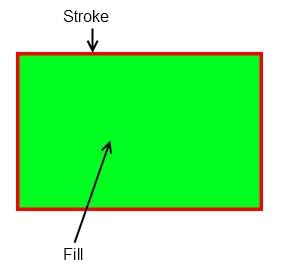Class 6 Exam > Class 6 Questions > What is the difference between stroke and fil...
Start Learning for Free
What is the difference between stroke and fill colour
?
?
Verified Answer
What is the difference between stroke and fill colour?
Stroke is line drawing, Fill is "colouring in" (for want of a better term).
So in the case of a shape (like a circle), the stroke is the border (circumference) and the fill is the body (interior).

 This question is part of UPSC exam. View all Class 6 courses
This question is part of UPSC exam. View all Class 6 courses
Most Upvoted Answer
What is the difference between stroke and fill colour?
Stroke Color
The stroke color refers to the color of the outline or border of a shape or object in a design or artwork. It is essentially the color that defines the edges of a shape and gives it a distinct shape or form. The stroke color can be applied to various elements such as lines, curves, and text.
Fill Color
The fill color, on the other hand, pertains to the color that is applied to the inside of a shape or object. It is the color that occupies the area within the boundaries defined by the stroke color. The fill color can be used to add depth, dimension, and visual interest to a design or artwork.
Differences
1. Role:
The primary difference between stroke and fill color lies in their roles within a design or artwork. The stroke color defines the outline or border of a shape, while the fill color fills the interior area of the shape.
2. Appearance:
- Stroke color: The stroke color is visible as a line or border around the shape. It can have different thicknesses, patterns, or styles, such as dashed or dotted lines.
- Fill color: The fill color is visible within the boundaries of the shape, giving it a solid or patterned appearance. It can be opaque or transparent, allowing other elements to show through.
3. Manipulation:
- Stroke color: The stroke color can be adjusted to change the thickness or style of the outline, allowing for customization and emphasis on certain elements.
- Fill color: The fill color can be modified to alter the overall color scheme of a shape or object, creating contrast, harmony, or focal points within the design.
4. Purpose:
- Stroke color: The stroke color is often used to define the edges of shapes and objects, making them stand out and separate from the background or other elements.
- Fill color: The fill color is used to add visual interest, depth, and dimension to a design. It can be used to distinguish different areas or elements within a composition.
Conclusion
In summary, the stroke color defines the outline or border of a shape, while the fill color fills the interior area of the shape. They play different roles in the overall appearance and manipulation of design elements, contributing to the visual appeal and communication of ideas in a design or artwork.
Attention Class 6 Students!
To make sure you are not studying endlessly, EduRev has designed Class 6 study material, with Structured Courses, Videos, & Test Series. Plus get personalized analysis, doubt solving and improvement plans to achieve a great score in Class 6.

|
Explore Courses for Class 6 exam
|

|
Similar Class 6 Doubts
What is the difference between stroke and fill colour?
Question Description
What is the difference between stroke and fill colour? for Class 6 2024 is part of Class 6 preparation. The Question and answers have been prepared according to the Class 6 exam syllabus. Information about What is the difference between stroke and fill colour? covers all topics & solutions for Class 6 2024 Exam. Find important definitions, questions, meanings, examples, exercises and tests below for What is the difference between stroke and fill colour?.
What is the difference between stroke and fill colour? for Class 6 2024 is part of Class 6 preparation. The Question and answers have been prepared according to the Class 6 exam syllabus. Information about What is the difference between stroke and fill colour? covers all topics & solutions for Class 6 2024 Exam. Find important definitions, questions, meanings, examples, exercises and tests below for What is the difference between stroke and fill colour?.
Solutions for What is the difference between stroke and fill colour? in English & in Hindi are available as part of our courses for Class 6.
Download more important topics, notes, lectures and mock test series for Class 6 Exam by signing up for free.
Here you can find the meaning of What is the difference between stroke and fill colour? defined & explained in the simplest way possible. Besides giving the explanation of
What is the difference between stroke and fill colour?, a detailed solution for What is the difference between stroke and fill colour? has been provided alongside types of What is the difference between stroke and fill colour? theory, EduRev gives you an
ample number of questions to practice What is the difference between stroke and fill colour? tests, examples and also practice Class 6 tests.

|
Explore Courses for Class 6 exam
|

|
Suggested Free Tests
Signup for Free!
Signup to see your scores go up within 7 days! Learn & Practice with 1000+ FREE Notes, Videos & Tests.

























